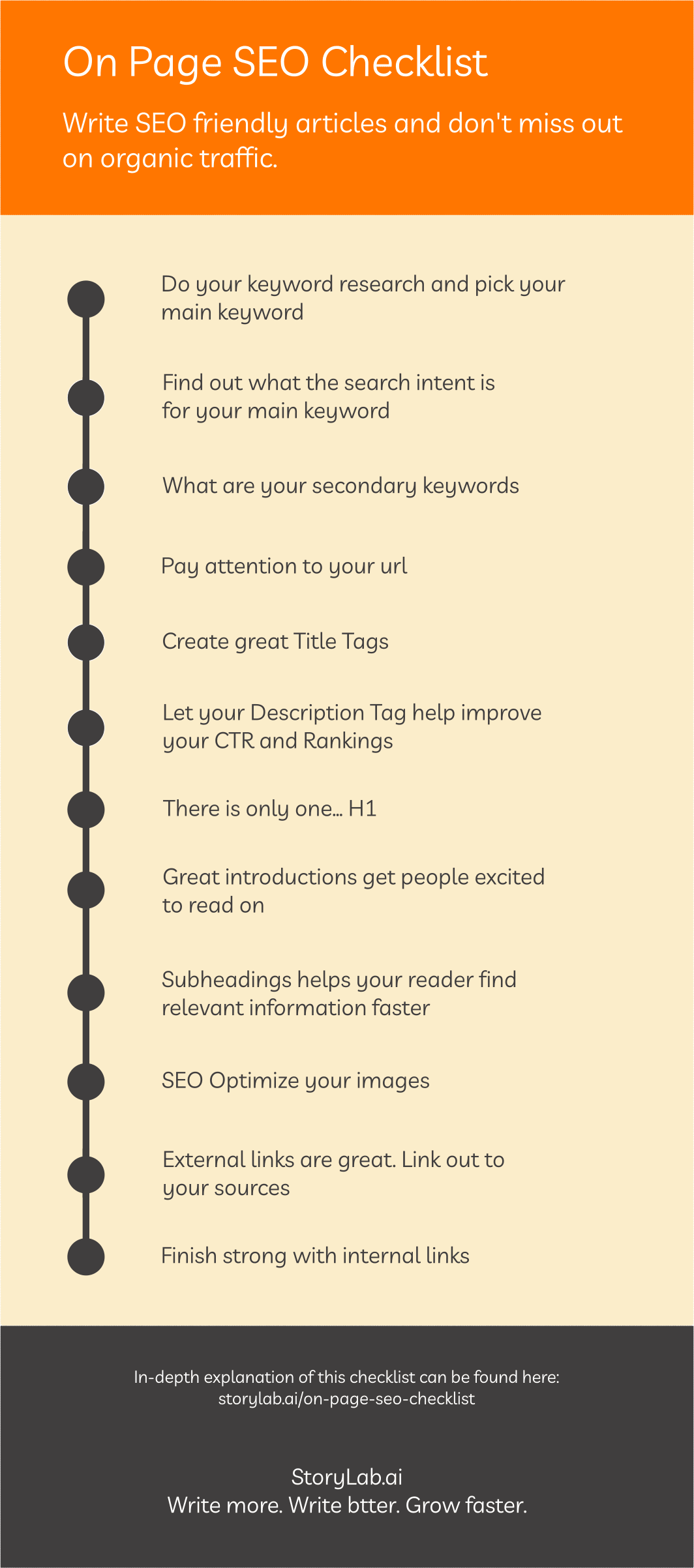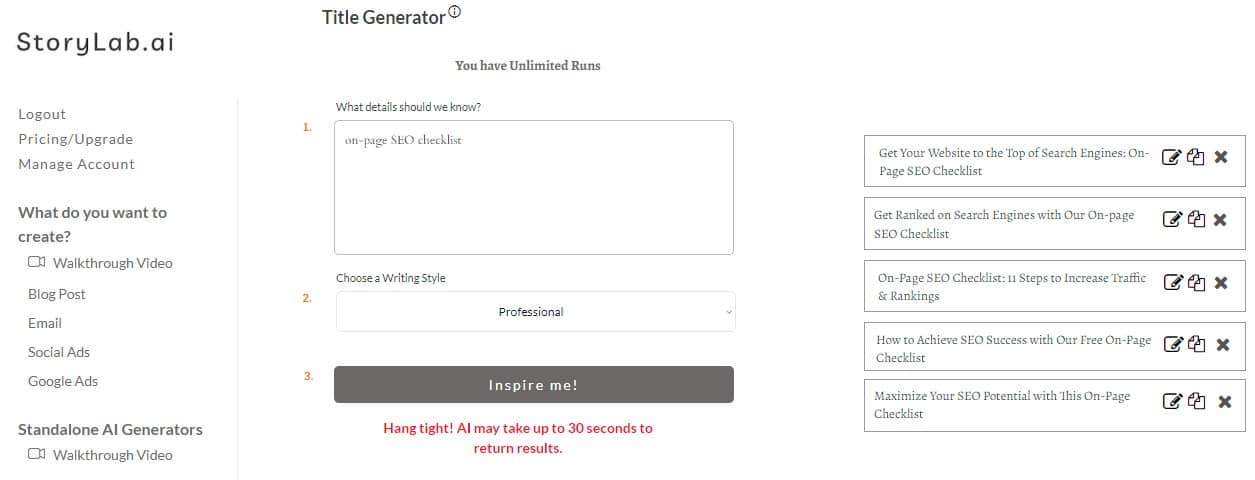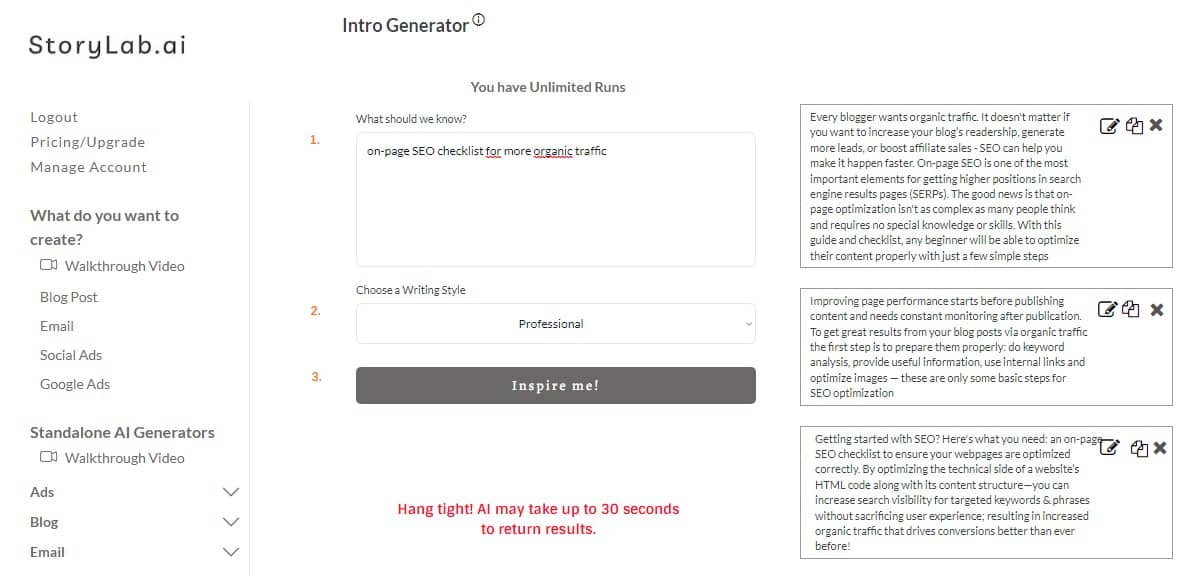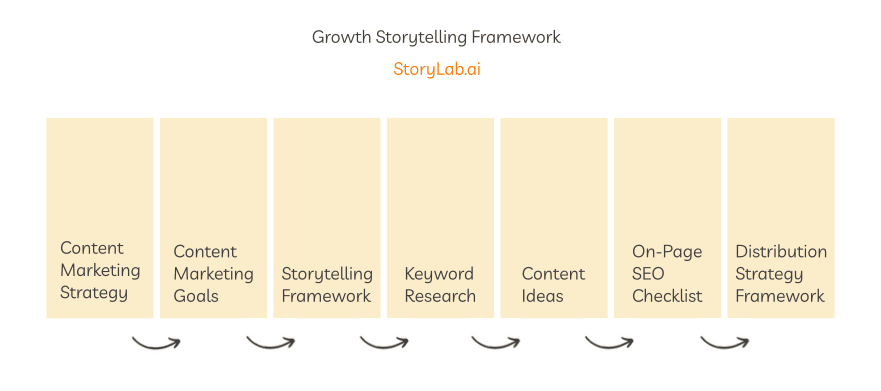On-Page SEO Checklist for More Organic Traffic in 2024
SEO is not complicated. A great checklist can get you a long way.
People often think that checklists are for beginners. That’s actually not true (per se).
It’s also for important tasks for which you simply can’t afford to make mistakes.
Pilots are very proficient in flying airplanes (lucky for us) but they still rely on checklists to be absolutely sure they have not overlooked anything. The same goes for doctors, scientists, and many others.
After you’ve spent all those resources on writing your article, would you be ok with rushing to publish it without doing an SEO check? Knowing that you’ll spend a lot of effort in promoting your piece of content in the hopes that it will rank number one in Google.
An On-Page SEO Checklist can help you to make sure that you did not overlook anything and increases your chances of obtaining that top position in SERP.
Our mission at StoryLab.ai, is to help you reach your goals through Growth Storytelling. Making sure that your content is being read by people searching for what you have to offer is a big part of that.
Check out the On-Page SEO Checklist we use for our content. It’s time-tested and easy to understand so everyone can get started with improving their rankings today.
You can use it when writing new content and also optimize your existing content. Be sure to integrate this checklist in your Inbound Marketing Strategy.

1. Do your keyword research and pick your main keyword
The person chasing two rabbits catches none.
You need to choose one main keyword that you want to focus your article around. For this article, we’re focusing on the keyword ‘On-Page SEO Checklist’. Why?
- Because the keyword ‘On-Page SEO’ is too competitive for us to try to rank for;
- If it would be our core offering, we would be ok with competing, but it’s not;
- We’re actually offering a checklist;
- This keyword has a decent search volume compared to the competition;
How did we even get to this topic?
We wanted to offer our SEO knowledge to our audience because we know that a lot of writers or content marketers are not per se SEO experts. After we decided on the topic we hopped over to SEMRush and did a little keyword research starting with the broad keyword ‘on-page SEO’.
2 Find out what the search intent is for your main keyword
For most keywords, Google already did thousands of a/b tests to find out what people searching for a particular keyword would like to see. It’s your job to offer better value compared to what’s already out there.
An example I oftentimes use is for the keyword ‘how to get rid of pimples’.
After thousands of a/b tests Google found out that people searching for that term want to get rid of pimples FAST!
Meaning, if you would write an article about how to get rid of pimples with a six weeks plan, you’re going to have a tough time.
You need to understand the intent of the searcher.
For this article, it’s pretty straightforward. An on-page SEO checklist.
BUT!
If everyone else on the first page of Google created great-looking tools, visuals, spreadsheets, etc, we can’t just write our top 5 tips and do a bunch of link-building.
It’s not what the searcher is looking for. So you won’t be able to keep your page one position. No matter the number of links.
3. What are your secondary keywords
We are strong advocates for creating a blog outline. It helps to get your thoughts on paper and also to figure out what your sub-topics are and do some additional keyword research to find additional ranking opportunities.
Check out how our Blog Outline Generator can help you out.
4. Pay attention to your URL
In general, shorter URLs tend to do better and you should include your main keyword. You want to be constantly updating your content. So avoid numbers like: 12-on-page-seo-tips-2024.
The article will still be relevant in 2024 and might give a wrong impression to users and search engines.
What if we add a tip in 2024? Do we change the URL and add redirects?
It’s best to just avoid it from the get-go.
5. Create great Title Tags
What you often read on the internet is that you should include your main keyword at the start of your title tag. And that’s true. You should definitely do that.
But take your title tag to the next level by getting people to click.
By having a catchy, value-driven title tag, more people will click on your result (more visitors) but Google also rewards you with better rankings because they see people prefer your content (as long as they don’t click the back button within a few seconds).
Check out how our AI-Powered Blog Title Generator can help you create catchy Title Tags.
For this example, we wanted to create a catchy title for this article. Our input was ‘on-page SEO checklist’, here’s what our AI tool generated for us:

Title Tag Examples Generated by AI:
- Get Your Website to the Top of Search Engines: On-Page SEO Checklist
- Get Ranked on Search Engines with Our On-page SEO Checklist
- On-Page SEO Checklist: 11 Steps to Increase Traffic & Rankings
- How to Achieve SEO Success with Our Free On-Page Checklist
- Maximize Your SEO Potential with This On-Page Checklist
Pretty cool right? The AI Title Generator is not an SEO-expert like you and me so we always need to check the order of the main and secondary keywords and add our unique human touch but the tool can for sure help inspire you. Here’s what the AI Generator created for us when we ran it two more times:
- Increase Rankings & Traffic with this Comprehensive On-Page SEO Checklist
- The Ultimate On-Page SEO Checklist: Increase Visibility & Conversion Rate
- Optimize Your Site for Maximum SEO Results – On-Page Checklist
- How to Optimize Your Pages for Maximum Search Engine Visibility
- Complete Guide to Improve Your On-Page SEO Ranking in 2024
- Quickly Optimize Your Website for SEO with this On-Page Checklist
- The Quick Guide to Optimizing Your Site for Maximum Search Visibility
- Increase Traffic & Rankings Instantly: A Comprehensive On-Page SEO Checklist
- Achieve Top Rankings in Search Engines with a Comprehensive On-page SEO Checklist
- Quick & Easy On-Page SEO Checklist to Boost Traffic
This should be enough to get the creative juices flowing, right?
6. Let your Description Tag help improve your CTR and Rankings
Be sure to use your description tag to compliment your title tag and boost your click through rates.
7. There is only one… H1
To be honest, we often time just use the Title Tag for our H1. Sometimes we shrink it down and sometimes we totally re-write it. The most important thing is that your main keyword is in there, that it shows people they landed on the right article and that you use the H1 tag only once in your article.
8. Great introductions get people excited to read on
Google hates pogo-sticking. They hate it when people click the back button within seconds. Your introduction should excite people to read your article and forget that there might be others out there.
Check out how our AI-Powered Blog Intro Generator can help you create exciting intros.
As an SEO best-practice, you should also include your main keyword in the first 150 characters of your body text.
Let’s see how our AI Blog Intro Generator helps us to create a cool intro for this article. Our input was ‘on-page SEO checklist for more organic traffic’

Introduction Examples Generated by AI:
- Every blogger wants organic traffic. It doesn’t matter if you want to increase your blog’s readership, generate more leads, or boost affiliate sales – SEO can help you make it happen faster. On-page SEO is one of the most important elements for getting higher positions in search engine results pages (SERPs). The good news is that on-page optimization isn’t as complex as many people think and requires no special knowledge or skills. With this guide and checklist, any beginner will be able to optimize their content properly with just a few simple steps
- Improving page performance starts before publishing content and needs constant monitoring after publication. To get great results from your blog posts via organic traffic the first step is to prepare them properly: do keyword analysis, provide useful information, use internal links and optimize images — these are only some basic steps for SEO optimization
- Getting started with SEO? Here’s what you need: an on-page SEO checklist to ensure your webpages are optimized correctly. By optimizing the technical side of a website’s HTML code along with its content structure—you can increase search visibility for targeted keywords & phrases without sacrificing user experience; resulting in increased organic traffic that drives conversions better than ever before!
Pretty cool right? Three nice examples so you don’t have to start with a blank page and you can simply re-run the generator to get new variations.
9. Subheadings help your reader find relevant information faster
Don’t think that every site visitor will read your article from start to finish. Chances are you already knew about a couple of the tips we’re providing. The Subheadings might have helped you to consume value faster.
Be sure to make the subheadings descriptive enough that they could act as standalone mini articles and Google might index them as such.
That means that this is a great place to add your secondary keywords as well.
10. SEO Optimize your images
This is also a pretty straightforward check from the On-Page SEO Checklist. Be sure your images are compressed. Check out tools like Compressor.io which can help you out.
Make sure the name of the image, description and alt tag are SEO Optimized. Meaning, describing the image and adding relevant keywords when possible.
11. External links are great. Link out to your sources
Google and your readers will love it when you link out to credible sources. Be sure to do it when applicable, but don’t overdo it. It’s not a thesis. You don’t need a source for every claim you make. For instance, this article was written mainly based on our years of experience and has just a few external links. Other articles have a lot more external links because we want to showcase how we acquired our findings.
Oh yeah. Don’t forget to always open external links in a new tab so people don’t leave your site without clicking that x in the top corner.
12. Finish strong with internal links
Internal links are great for boosting articles you want to rank without acquiring external links. But there is a right and a wrong way to make use of internal links. Here are some tips:
- Don’t add too many internal links. The authority that flows from one page linking to 10 articles is less than when linking to 5 articles.
- Preferably, only link to articles that you want to rank. You might have web pages that just need a small boost to reach that top 1 position. Try to link to such articles over random articles that in 2 years never even saw page 20 of Google.
- Link to highly relevant pages with the right anchor text.
- Build hubs and link articles to one another. We do that with our Marketing Copy Generators for instance. The Title Generator Links to the Intro Generator which links to the Instagram Caption Generator, etc.
- When you publish an article, check from which pages you can get internal links.
- Pro tip! Go back and delete internal links if you see that articles don’t rank.
Wrapping up
So there you have it.
A Checklist to write a SEO friendly articles. It might look like a lot, but constantly writing articles without seeing any results is more work than optimizing the articles that you already have.
How to start SEO optimizing your content today?
If you have just a couple of articles written, you can simply start and optimize them all.
If you have a ton of articles written, I would:
- Check which articles show the most potential and start running them through this checklist. Step-by-step.
- For the rest of the articles, focus on:
- Understanding the search intent;
- Finding your primary and secondary keyword;
- Optimize your title tag and H1;
- Check which articles deserve some internal links.
- When you’re finished with those actions, check which articles are getting a bump and run those through the entire checklist.
- Run every article you write from now on through this checklist. Step-by-step.
- Be sure to make use of our AI Marketing Copy Generators to help you write better content. Fast.
Getting the most out of your Content Marketing Efforts
On-Page SEO is just one piece of the entire Content Marketing puzzle.
For instance, you can optimize your content for SEO perfectly, but if your content does not evoke any emotion and does not get people to take a next step, what good does it do?
Our On-Page SEO Checklist sits within a Growth Storytelling Framework. You can access it here for free. No signup needed.
Go forth and create the best possible content and tell your best stories.
We will be here to support you however we can. You can ask us any question in our LinkedIn group.

Related articles
- Content Marketing Goals and KPIs
- How to come up with effective content ideas
- How to find the best Hashtags
FAQs
Why do you need on-page SEO optimization?
Search engines need to understand what your page is about and on-page search engine optimization helps content creators to communicate this to search engine crawlers.
Also. There are only 10 spots on the first page of the Search Engine Result Page (SERP). The better you pay attention to on-page optimization techniques, the better the chances that you can claim and hold a spot on the first page of Google.
What is the first step for on-page SEO optimization?
The first step is to analyze all the content you currently have and understand which ones need your attention first. After you’ve identified the most important pages, start with the on-page optimization techniques that drive the most impact or you’ve neglected completely. For instance, starting with optimizing your H1s, Title, and Description Tags is a good start. But only if you have already conducted your keyword research. Otherwise, you don’t know which keywords to include.
What is Whitehat and Blackhat SEO
Whitehat SEO is following the Search Engine guidelines and Blackhat SEO is taking actions that go against a search engine’s guidelines. For instance, adding keywords to a page and having them match the background (which makes them invisible (yes people used to do that)) or buying links.
All on-page SEO techniques covered in this article are whitehat SEO techniques. You’re basically working together with Google to create the best content for a given search query and communicating what your content is about. Search Engines love that!
What is on-page SEO?
On-page SEO involves optimizing web page content for search engines and users. Common on-page SEO practices include optimizing title tags, content, internal links, and URLs.
How does keyword optimization impact on-page SEO?
Keyword optimization is crucial for on-page SEO. It involves using relevant keywords in your content, including titles, headings, and throughout the body text, in a way that feels natural and relevant.
What role do title tags play in on-page SEO?
Title tags are critical in on-page SEO as they provide search engines and users with a quick insight into the content of the web page, influencing click-through rates from search engine results pages.
How important are meta descriptions for on-page SEO?
Meta descriptions, while not directly impacting rankings, are vital for providing a brief summary of the page in search results and can influence the likelihood of a user clicking through to the site.
What is the significance of header tags in on-page SEO?
Header tags (H1, H2, H3, etc.) help organize content and signal to search engines what a section or a page is about. Proper use of header tags can enhance SEO and user experience.
How does URL structure affect on-page SEO?
A well-structured URL that includes keywords and is easy to understand can provide both search engines and users with more information about the page, benefiting SEO.
What impact does site speed have on on-page SEO?
Site speed is a crucial factor in on-page SEO. Faster loading times improve user experience and are favored by search engines, potentially impacting rankings.
How do internal linking strategies benefit on-page SEO?
Internal linking helps distribute page authority throughout your website, aids in website navigation, and helps search engines crawl the site more effectively.
What is the importance of content quality in on-page SEO?
High-quality, relevant content is essential for on-page SEO. Content should provide value to the user, be well-written, and include keywords appropriately.
Can images and multimedia improve on-page SEO?
Yes, optimizing images and multimedia content with descriptive file names and alt text can improve on-page SEO by making your page more engaging and accessible, and by providing search engines with additional context.
Jump back to a section
- 1. Doe je zoekwoordenonderzoek en kies je belangrijkste zoekwoord
- 2 Zoek uit wat de zoekintentie is voor uw hoofdzoekwoord
- 3. Wat zijn uw secundaire zoekwoorden
- 4. Let op uw URL
- 5. Maak geweldige titeltags
- 6. Laat uw Description Tag helpen uw CTR en rankings te verbeteren
- 7. Er is er maar één... H1
- 8. Geweldige introducties zorgen ervoor dat mensen enthousiast worden om verder te lezen
- 9. Tussenkopjes helpen je lezer om sneller relevante informatie te vinden
- 10. SEO Optimaliseer je afbeeldingen
- 11. Externe links zijn geweldig. Link naar je bronnen
- 12. Werk sterk af met interne links
- Afsluiten
- Haal het meeste uit uw inspanningen op het gebied van contentmarketing
Author bio:
 Raul Tiru: Raul loves to build companies and help startups and scale-ups grow. Raul started his first website when he was 17 years old, has held several growth marketing positions in fast-growing companies, and has helped companies via his Freelance Marketing services. You can find Raul on his community GlobalOwls where he helps Nonprofits and Startups to do better marketing.
Raul Tiru: Raul loves to build companies and help startups and scale-ups grow. Raul started his first website when he was 17 years old, has held several growth marketing positions in fast-growing companies, and has helped companies via his Freelance Marketing services. You can find Raul on his community GlobalOwls where he helps Nonprofits and Startups to do better marketing.
Master the Art of Video Marketing
AI-Powered Tools to Ideate, Optimize, and Amplify!
- Spark Creativity: Unleash the most effective video ideas, scripts, and engaging hooks with our AI Generators.
- Optimize Instantly: Elevate your YouTube presence by optimizing video Titles, Descriptions, and Tags in seconds.
- Amplify Your Reach: Effortlessly craft social media, email, and ad copy to maximize your video’s impact.